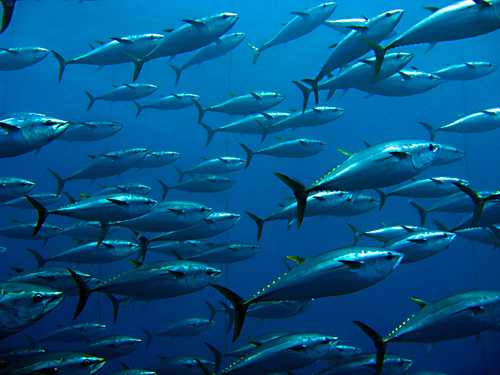Tuna, Mercury and Bioaccumulation: Have Humans Made it Worse?
Question: Have large fish like sharks and tunas always had lots of mercury, or is that because of us? - Jordan F.
Answer: Mercury has always been part of the environment and has always bioaccumulated into top predator fish, but human activities since the industrial revolution have made this problem much worse. You may have seen advice to limit the amount of certain types of fish in your diet, especially if you are pregnant or may become pregnant, based on mercury levels. These recommendations are mostly for fish like swordfish, shark and some kinds of tuna, but also include other top predators like king mackerel, tilefish and orange roughy, according to the FDA. But what’s the deal with mercury in sharks and other fish? Why is it bad for us? Why is it a bigger problem when eating some fish than others? And, how did it get into the environment in the first place?
First, let’s clarify that there are different mercury compounds, and we are talking about methylmercury, not the ethylmercury that is found in some vaccines and is completely harmless. Methylmercury can cause a variety of harmful effects, especially to the nervous system, according to the World Health Organization (WHO), which notes that developing fetuses are the most vulnerable to these effects. The WHO also advises that the effects of methylmercury depend on the dosage that people are exposed to (which means that a claim I’ve sometimes seen, that eating shark once means your brain will be forever destroyed, is pseudoscientific nonsense).
Where does methylmercury come from? Mercury is naturally found in the Earth’s crust and enters the broader environment through various natural processes. But it’s humans–mostly humans burning coal, but also through some mining practices and other local-scale processes–that have released the most mercury into the environment. Since the industrial revolution, when we started burning coal en masse, mercury levels in the surface ocean have more than tripled.
Why is it worse in top predators like tuna, swordfish and sharks? Mercury levels are worse in top predators due to the bioaccumulation and biomagnification of methylmercury. This means that the higher up the food chain you go, the higher the concentration of methylmercury–which cannot be digested or processed by organisms–is in the systems of those animals. For what it’s worth, “don’t eat fish of any kind while pregnant,” which is a common version of the “don’t eat too much tuna or swordfish if you’re pregnant” advice that I’ve seen, is not supported by sources like the FDA or the Mayo Clinic, which note that seafood is healthy and contains nutrients important for adults and for growing babies. The issue primarily concerns top predator fish.
Ask a Marine Biologist is a monthly column where Dr. David Shiffman answers your questions about the underwater world. Topics are chosen from reader-submitted queries as well as data from common internet searches. If you have a question you’d like answered in a future Ask a Marine Biologist column, or if you have a question about the answer given in this column, email Shiffman at This email address is being protected from spambots. You need JavaScript enabled to view it. with subject line “Ask a marine biologist.”
Dr. David Shiffman is a marine conservation biologist specializing in the ecology and conservation of sharks. An award-winning public science educator, David has spoken to thousands of people around the world about marine biology and conservation and has bylines with the Washington Post, Scientific American, New Scientist, Gizmodo and more. Follow him on @WhySharksMatter on Twitter, Facebook and Instagram, where he’s always happy to answer any questions about sharks.
The views expressed in this article are those of David Shiffman, and not necessarily the views Scuba Diving magazine.

When you subscribe to the blog, we will send you an e-mail when there are new updates on the site so you wouldn't miss them.
